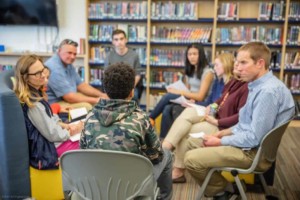Review: The Multiplayer Classroom by Lee Sheldon
 “Play the game” or “life’s a game” are a phrases commonly thrown around when people are discussing a challenge in the workplace or at school. We say that to mean – look at life like a game of chess that requires you to make calculated risks, problem solve, rise to challenges and interact with others. The big question is: Can everything in life be game?
“Play the game” or “life’s a game” are a phrases commonly thrown around when people are discussing a challenge in the workplace or at school. We say that to mean – look at life like a game of chess that requires you to make calculated risks, problem solve, rise to challenges and interact with others. The big question is: Can everything in life be game?
According to Associate Professor and Co-Director at the Games and Simulation Arts and Sciences program at Rensselaer Polytechnic Institute, Lee Sheldon, the answer is yes or at least when it comes to learning in the classroom. In fact, his recent book The Multiplayer Classroom: Designing Coursework as a Game explores games for learning from the perspective of a game. Let’s take a look.
Sheldon’s witty book takes the virtual world of games and brings it into reality and teaching. The first “level” (as opposed to chapter) in his book begins on the first day of the class where he says, “Good morning. Welcome to the first class of the semester. Everyone in this class is going to receive an F.” He goes on to say that the students in his class need to rise up in level, just as they would in a video game, to receive a higher grade (3-4). This, like many video games, captures students’ interests and engages them in what might come next.
According to the game design in the book, students in a multiplayer classroom receive experience points or XP rather than grades or assignment points. I think this is a great distinction that reminds students that all work, including assignments and projects, are experiences that attribute to their learning. This perspective asks students to view their learning in a different way – a game that allows students to grasp hold of their own experiences.
Oftentimes when serious games or games for learning are discussed, it’s in regards to video games or simulations to supplement learning. Yet the in-depth designs, syllabi, curriculums and grading that Sheldon covers looks at games that don’t necessarily involve technology and are related more to the setup of the class and classroom management.
Sheldon articulates that while learning through play or fun games is not a new concept, it’s one that is slowly adopted in the classroom. Oftentimes games or fun learning isn’t taken as seriously as other lessons in the classroom, yet can be equally if not more effective.
In fact, the book looks at a Biology class at the low-income school Mark Tree High School in Arkansas that saw a 36 percent increase in the passing rate and a 26 percent increase in students who averaged a B or better in a year’s time as just one example among many (55-56). Sheldon says that games and the learning success that they bring increase student motivation, attitude and performance – boosting the overall atmosphere of the classroom.
In the book, Sheldon also explores personal case studies he conducted with two classes, looking at the successes and failures of implementing a multiplayer classroom. These case studies support theories for game-based learning and reasons why many schools and charters are erupting around the country with this focus.
Keep an eye on game-based learning, game-based schools, and serious games in the near future. Maybe all learning will be based, as Sheldon suggestions, on a game.
Click here for more information on The Multiplayer Classroom: Designing Coursework as a Game.







0 Comments
Leave a Comment
Your email address will not be published. All fields are required.